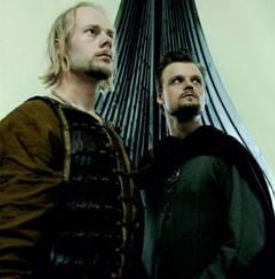Icelandic E-Journal of Nordic and Mediterranean Studies
to a more traditional form of black metal, allowing themselves only patterns of clean vocals and some excerpts of strings and saxophone as variations. The lyrics followed a narrative pattern that gave little space to speculation — the story is narrated as it is, as an Odyssey through an ancient time, with no pretension of having something to do with the present age. Jakhelln and Nedland also chose to wear Viking costumes in promotional photographs, as they were in vogue among Viking metal bands, which made quite a contrast to how they were used to appearing as a band (the pictures below show Solefald before and after the „Viking‟ albums. Jakhelln is on the left in both of them).[1]
To most Solefald fans, these albums were difficult to tackle. After having taken up
black metal, revolutionized and deconstructed it, they returned back to their roots,
both lyrically and musically, releasing two albums which would fit in with the
standards of the genre from ten years before. When asked about the reason for such a
choice, the band answered, somewhat ironically, that „Solefald was experimenting
when everybody was being true. Now that things are changing and that we‟ve pushed
the experiment quite far already, we wanted Red For Fire and Black For Death to be
our attempts at being true. This will be a true Nordic Viking Metal album.‟[2] Not
only did the band refer to a black metal „trueness‟ they never shared (and to which I
shall come back to) and to a subgenre — Viking metal — of which they never claimed
to be a part; Solefald also dropped the old label „red music with black edges‟ in favour
of a more general „avant-garde black metal‟, which stands both at the top of their
official online biography and in the sleeves of their latest albums.
This return to the roots reached its peak between 2007 and 2008, when Jakhelln
published the last part of his poetic tetralogy, Galderhug. Quadra Natura 1111 and
his first novel, Gudenes Fall [The Fall of the Gods].[3] Galderhug is a collection of
poems which are quite in keeping with Jakhelln‟s previous production, borrowing
themes and models from Norse poetry yet trying to reinterpret them in a modern
context. Galderhug is also Jakhelln‟s first attempt to reach readers outside the
Norwegian market, as all poems were published in both Norwegian and English.
More interesting for our subject is Jakhelln‟s sagaroman („saga-novel‟) Gudenes Fall,
30


